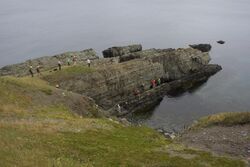Earth:Fortunian
| Fortunian | |
|---|---|
| 538.8 ± 0.2 – ~529 Ma | |
 Delegates from the Ichnia 2012 conference inspect the Global Boundary Stratotype Section and Point (GSSP) for the Ediacaran-Cambrian boundary at Fortune Head Ecological Reserve, Newfoundland, Canada. | |
| Chronology | |
Cambrian graphical timeline -540 — – -535 — – -530 — – -525 — – -520 — – -515 — – -510 — – -505 — – -500 — – -495 — – -490 — – -485 — – Major Glacial period | |
| Etymology | |
| Name formality | Formal |
| Name ratified | 2007[2] |
| Former name(s) | Cambrian Stage 1 |
| Usage information | |
| Celestial body | Earth |
| Regional usage | Global (ICS) |
| Time scale(s) used | ICS Time Scale |
| Definition | |
| Chronological unit | Age |
| Stratigraphic unit | Stage |
| First proposed by | Ed Landing, 2007[3] |
| Time span formality | Formal |
| Lower boundary definition | Appearance of the Ichnofossil Treptichnus pedum |
| Lower boundary GSSP | Fortune Head section, Newfoundland, Canada [ ⚑ ] 47°04′34″N 55°49′52″W / 47.0762°N 55.8310°W |
| GSSP ratified | 2007 (as base of Terreneuvian and Fortunian)[2] |
| Upper boundary definition | Not formally defined |
| Upper boundary definition candidates | First appearance of small shelly fauna or Archaeocyathids |
| Upper boundary GSSP candidate section(s) | None |
[ ⚑ ] 47°04′34″N 55°49′52″W / 47.0762°N 55.8310°W The Fortunian age marks the beginning of the Phanerozoic Eon, the Paleozoic Era, and the Cambrian Period. It is the first of the two stages of the Terreneuvian series. Its base is defined as the first appearance of the trace fossil Treptichnus pedum 541 million years ago. The top of the Fortunian which is the base of the Stage 2 of the Cambrian has not been formally defined yet, but will correspond to the appearance of an Archeocyatha species or "Small shelly fossils" approximately 529 million years ago.[4]
The name Fortunian is derived from the town of Fortune on the Burin Peninsula, near the GSSP and Fortune Bay.[5]
GSSP
The type locality (GSSP) of the Fortunian stage is in Fortune Head, at the northern edge of the Burin Peninsula, Newfoundland, Canada ( [ ⚑ ] 47°04′34″N 55°49′52″W / 47.0762°N 55.8310°W). This GSSP coincides with the base of the Terreneuvian series, the Precambrian-Cambrian boundary and the beginning of the Phanerozoic. The outcrops show a carbonate-siliciclastic succession which is mapped as the Chapel Island Formation. The formation is divided into the following members that are composed of peritidal sandstones and shales (Member 1), muddy deltaic and shelf sandstones and mudstones (Member 2A), laminated siltstones (Member 2B and 3) and mudstones and limestones of the inner shelf (Member 4). The Precambrian-Cambrian boundary lies 2.4 m above the base of the 2nd member which is the lowest occurrence of Treptichnus pedum. The traces can be seen on the lower surface of the sandstone layers. The first calcareous shelled skeletal fossils (Ladatheca cylindrica) is 400 m above the boundary. The first trilobites appear 1,400 m above the boundary, which corresponds to the beginning of the Branchian Series.[6]
See also
- Stratigraphy of the Cambrian
References
- ↑ "Chart/Time Scale". International Commission on Stratigraphy. http://www.stratigraphy.org/index.php/ics-chart-timescale.
- ↑ 2.0 2.1 Landing, Ed; Peng, Shanchi; Babcock, Loren; Geyer, Gerd; Moczydlowska-Vidal, Malgorzata (December 2007). "Global standard names for the Lowermost Cambrian Series and Stage". Episodes 30 (4): 287–289. doi:10.18814/epiiugs/2007/v30i4/004. https://www.researchgate.net/publication/254558720. Retrieved 13 December 2020.
- ↑ Landing, Ed. "THE BASE OF THE CAMBRIAN: TERRENEUVIAN SERIES AND FORTUNIAN STAGE". http://www.palaeontology.geo.uu.se/ISCS/ISCS_GSSPs.html.
- ↑ "Global Boundary Stratotype Section and Point". International Commission of Stratigraphy. http://www.stratigraphy.org/GSSP/index.html.
- ↑ Landing, E. "THE BASE OF THE CAMBRIAN: TERRENEUVIAN SERIES AND FORTUNIAN STAGE". http://www.palaeontology.geo.uu.se/ISCS/ISCS_Terreneuvian_Fortunian_2007.pdf.
- ↑ Brasier, Martin; John Cowie; Michael Taylor (1994). "Decision on the Precambrian-Cambrian boundary stratotype". Episodes 17 (1–2): 95–100. doi:10.18814/epiiugs/1994/v17i1.2/002. http://www.stratigraphy.org/GSSP/file46.pdf. Retrieved 14 September 2012.
External links
- Martin, Anthony (Tony) (27 August 2012). "Out of One's Depth in the Ediacaran". http://www.georgialifetraces.com/2012/08/27/out-of-ones-depth-in-the-ediacaran/.
- Martin, Anthony (Tony) (23 August 2012). "Mistaken Point and the Limits of Actualism". http://www.georgialifetraces.com/2012/08/23/mistaken-point-and-the-limits-of-actualism/.
- Album of the Ichnia 2012 conference at Fortune Head
 |

